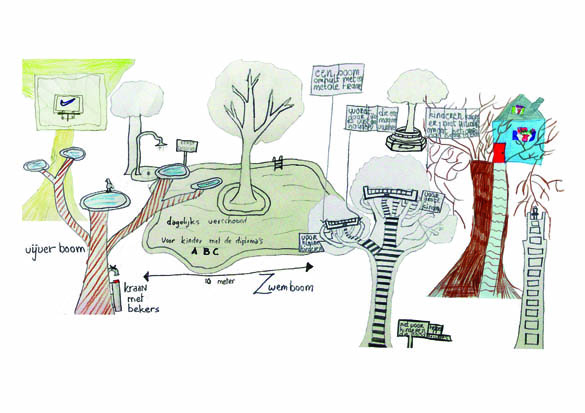Phase 0: Starting pointPhase 1: ExploringPhase 2: SketchingPhase 3: ConsultationThinkingShapingWorkshop 50+ (2)Toddler LabYoungsters workshopWorkshop local women (3)Workshop local women (4)MakingWorkshop local menWorkshop local girls (2)PresentationPreliminary designPhase 4: BuildingPhase 5: Executing
3 scenarios into 1 design
The next assignment was to combine these three scenarios into a single design. The schoolchildren were set to work in a more specific way during this period. For several weeks they had to hunker down and work out one of the ideas. The different ideas had to be worked out more specifically. Intensive consultation with local residents took place during this period. Not only did they now have to think about what their idea would look like, they also had to make their vision fit into a ground plan for the park. During the week before the final presentation of the Preliminary design to the city council, the schoolchildren received the assistance of a designer and an architect. They helped translate the designs into technical drawings in which scale, materials and feasibility were taken into account. Multifunctional green
Multifunctional green
The first layer: the landscape
The Preliminary design consists of two different layers. The first layer is the landscape, or the base layer. This ensures that the site has a park-like character and that access is provided to the area. This base layer consists of an uneven surface primarily covered in grass. The park is made up of one large and several smaller hillocks. In addition, a large quantity of trees in the park will be preserved, relocated or newly planted. This base layer also provides access. A simple solution was chosen, based on one of the schoolchildren’s designs. The pupil in question proposed a simple oval path in the shape of a running track. In the final design, it was decided to double this shape, creating a sort of paperclip. This paperclip divides the park in three sections. The first section is a narrow zone along the side where the park adjoins the community school. This zone is designated as a playground zone. The second zone is the rest zone, a quiet section with much ornamental greenery, benches and a fountain. The third zone is the activity zone.The second layer: the objects
The second layer consists of the series of ‘urban’ objects. These objects are imbedded in the base layer in such a way as to disrupt its park-like character as little as possible. So the multi-function concrete sports field will be slightly sunken. This provides several advantages. It makes this large structure less noticeable, and the balls are less likely to land outside the sports field. Finally, the raised edge can be used for seating. The Multi-Podium/Grandstand will be incorporated into the large hillock so that the structure can serves as a grandstand for the adjacent sports field but at the same time separates the quiet rest area from the activity zone. The Climbing Wall/Supervisor’s Post will be situated next to the sports field and he fountain will be located in the rest /family area.The Chilling’ Area was placed at the opposite site of the family area to give young people more privacy. The original ‘place to chill’ devised by the youngsters was a sloping circular structure. In order to avoid making the structure too conspicuous within the park, it was made as the negative of this shape, creating a sort of sitting pit. Next to it, the Staalman is put. The Do-Trees combined with a number of play facilities are placed in the narrow zone parallel to the grounds of the community school. The whole park would have a low and relatively open fence. The idea was to elaborate the diamond pattern of the wire netting into more complex motifs.